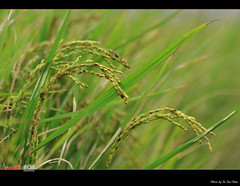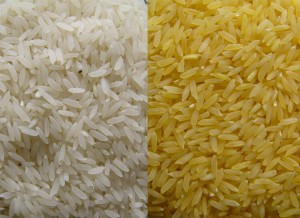Looks like the search engine is finally letting me put the annoying hacking of this site over the summer behind me.
November 14, 2009
Marker Assisted Breeding
Some traits are easy to select for. It’s easy to tell which plants have a gene that turns them purple, or almost any of the mutants seen in the mutants of corn garden at cornell. When I was an undergrad some of the world I did was with a gene that (when it wasn’t knocked out by a transposon) turned corn kernals dark purple. Traits like that one (the R gene) that can be identified just from looking at a seed are the easiest of all.
Other traits are not so easy to select for. How do you pick out which plants in a row carry a gene variant that increases yield by 6%? Or worse yet, yields 6% more under drought conditions, but has no effect otherwise? For improving crops a plant breeder will need to track gene variants for many generations under in all sorts of growing conditions. (more…)
Genetically Engineered Crops: Rice
Scientific name: Orzya sativa
Genetically Engineered Traits: Herbicide tolerance, insect resistance (bt), increased vitamin A content
Details of Genetic Engineering:
Rice genetically engineered to be resistant to glufosinate (developed by Bayer CropScience) has been approved (deregulated) in the US but is not yet for sale commercially as the company attempts to get approval in countries which import rice from the US as well.
As far as I know, no company in the US has produced bt rice, which has less to do with consumer fears than with the small amount of rice production in the US rather than consumer rejection, but that’s just a guess. The Chinese government has developed breeds of bt rice, but doesn’t grow them commercially because of the risk to their export markets, which is primarily to countries that reject genetic engineering (although Chinese rice exports are declining drastically as more and more of their production is needed to feed their own people).
Golden rice, which has betacarotene, which human bodies need to make vitamin A, was developed by in Swizerland in the 1990s. Almost all plants produce carotenoids like betacarotene in their leaves as part of the biological machinery that makes photosynthesis possible. Breeders can sometimes identify and propogate natural mutations which lead to the expression of carotenoids in other parts of the plant, two key examples are orange carrots* and orange cauliflower. Vitamin A deficiency is a major issue** in many countries were rice is the primary crop, so breeders have searched for decades for natural mutations at would create orange rice, without success.*** The initial breed of golden rice which used two genes, one from daffodile to promote the expression of carotenoids in the grains of rice was attacked as requiring people to eat more than a dozen bowls of rice a day to get their daily recommended vitamin A intake, new versions that replaced the gene taken from daffodil with a version of the same gene taken from corn have more than twenty times as much beta carotene. Golden rice is also not currently grown commercially as it, like ringspot resistant papaya, doesn’t have a powerful for-profit corporation to shepherd it through the complex approval processes of various nations.
About Rice:
(more…)

